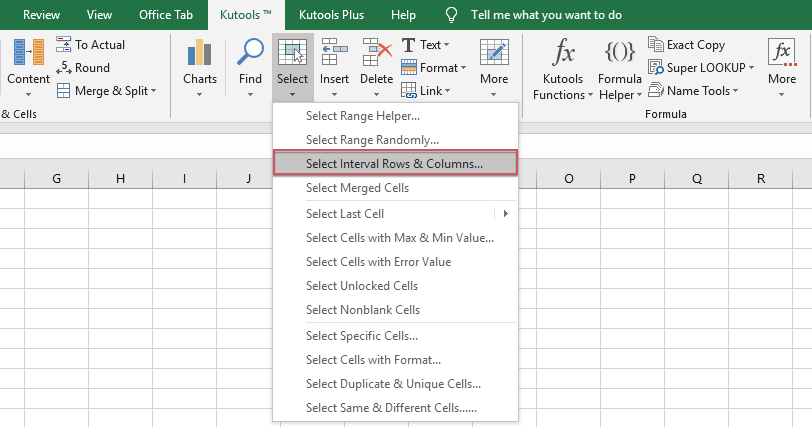如何快速對 Excel 中的每隔一行或第 n 行/列求和?
眾所周知,我們可以使用 Sum 函數來添加一組儲存格,但有時出於某些目的,我們需要對每隔一個儲存格進行求和,而 Excel 沒有標準函數允許我們對每隔第 n 個儲存格求和。在這種情況下,我們如何對 Excel 中每隔一行或第 n 行/列求和呢?
使用 Kutools for Excel 對每隔一行或第 n 行/列求和/平均值/計數
使用公式對每隔一行或第 n 行/列求和
通過以下示例,我將向您展示如何應用這些公式來對每隔一個儲存格進行求和。
1. 使用陣列公式對每隔一行或列求和
在空白儲存格中,請輸入此公式:=SUM(IF(MOD(ROW($B$1:$B$15),2)=0,$B$1:$B$15,0)) ,然後按下 Ctrl + Shift + Enter 鍵,B 列中每隔一個儲存格的值就已經被求和了。請參見截圖:
 |  |
注意:
1. 在上述陣列公式中,您可以將數字 2 改為 3、4、5…,這意味著每隔 3 行、每隔 4 行、每隔 5 行求和…
2. 如果您想對每隔一列求和,可以輸入以下公式:=SUM(IF(MOD(COLUMN($A$1:$O$1),2)=0,$A$1:$O$1,0)),然後按下 Ctrl + Shift + Enter 鍵以獲得結果。請參見截圖:

2. 使用公式對每隔一行或列求和
這裡還有另一個公式可以幫助您對工作表中的每隔一個或第 n 個儲存格求和。
在空白儲存格中,請輸入此公式:=SUMPRODUCT((MOD(ROW($B$1:$B$15),3)=0)*($B$1:$B$15))。然後按下 Enter 鍵,每第 3 個儲存格就已經被相加了。請參見截圖:
 |  |
注意:
1. 在上述公式中,您可以將數字 3 改為 4、5、6…,這意味著每隔 4 行、每隔 5 行、每隔 6 行求和…
2. 如果您想對每隔一列求和,可以輸入以下公式:=SUMPRODUCT((MOD(COLUMN($A$1:$O$1),3)=0)*($A$1:$O$1))。


使用 Kutools AI 解鎖 Excel 的魔法
- 智能執行:執行單元格操作、分析數據並創建圖表——所有這些都由簡單的指令驅動。
- 自訂公式:生成量身定制的公式,簡化您的工作流程。
- VBA 編碼:輕鬆編寫和實現 VBA 代碼。
- 公式解釋:輕鬆理解複雜的公式。
- 文本翻譯:打破電子表格中的語言障礙。
使用用戶定義函數對每隔一行或第 n 行/列求和
以下用戶定義函數也可以幫助您在 Excel 中添加每隔一個或第 n 個儲存格。
1. 按住 ALT + F11 鍵,打開 Microsoft Visual Basic for Applications 視窗。
2. 點擊 插入 > 模組,並將以下代碼粘貼到模組視窗中。
Function SumIntervalRows(WorkRng As Range, interval As Integer) As Double
'Updateby Extendoffice
Dim arr As Variant
Dim total As Double
total = 0
arr = WorkRng.Value
For i = interval To UBound(arr, 1) Step interval
total = total + arr(i, 1)
Next
SumIntervalRows = total
End Function
Function SumIntervalCols(WorkRng As Range, interval As Integer) As Double
Dim arr As Variant
Dim total As Double
total = 0
arr = WorkRng.Value
For j = interval To UBound(arr, 2) Step interval
total = total + arr(1, j)
Next
SumIntervalCols = total
End Function
3. 然後保存此代碼,並根據需要在空白儲存格中輸入以下公式,請參見截圖:
對於每隔四行求和:=SumIntervalRows (B1:B15,4)

對於每隔四列求和: =SumIntervalCols (A1:O1,4)

4. 然後按下 Enter 鍵,您將得到計算結果。請參見截圖:
每隔四行求和:

每隔四列求和:

注意:您可以將數字 4 改為任何其他數字,例如 2、3、5…,這意味著每隔第二行、每隔第三行、每隔第五行或列求和。
使用 Kutools for Excel 對每隔一行或第 n 行/列求和/平均值/計數
也許公式和用戶定義函數對大多數人來說有些困難,這裡我可以介紹一種更簡單的方法來解決這個問題。
使用 Kutools for Excel 的 選擇間隔行與列 功能,您可以先選擇每隔一個或第 n 個所需的儲存格,然後為選中的儲存格指定一個定義名稱,最後使用 Sum 函數對這些儲存格求和。
安裝 Kutools for Excel 後,請按照以下步驟操作:
1. 選擇要對每隔一個或第 n 個儲存格求和的列。
2. 點擊 Kutools > 選擇 > 選擇間隔行與列,請參見截圖:

3. 在 選擇間隔行與列 對話框中,根據需要指定操作,請參見截圖:
4. 點擊 確定,從第一行開始每隔一行都已被選中,現在您可以查看計算結果,例如平均值、總和、計數等顯示在狀態欄的底部。請參見截圖:

注意:
1. 使用此功能,您可以在 間隔 設置中設置數字 2、3、4…,並且您將選擇間隔為 2、3、4 行的儲存格,從步驟 3 中範圍的第一行開始。
2. 使用上述步驟,您還可以根據需要對每隔一列或第 n 列求和。
相關文章:
最佳 Office 生產力工具
| 🤖 | Kutools AI 助手:以智能執行為基礎,革新數據分析 |生成程式碼 | 創建自訂公式 | 分析數據並生成圖表 | 調用 Kutools 增強函數… |
| 熱門功能:查找、選取項目的背景色或標記重複值 | 刪除空行 | 合併列或單元格且不遺失數據 | 四捨五入(免公式)... | |
| 高級 LOOKUP:多條件 VLookup|多值 VLookup|多表查找|模糊查找... | |
| 高級下拉列表:快速創建下拉列表 |依賴型下拉列表 | 多選下拉列表... | |
| 列管理器:添加指定數量的列 | 移動列 | 切換隱藏列的顯示狀態 | 比較區域及列... | |
| 精選功能:網格聚焦 | 設計檢視 | 增強編輯欄 | 工作簿及工作表管理器 | 資源庫(快捷文本) | 日期提取器 | 合併資料 | 加密/解密儲存格 | 按列表發送電子郵件 | 超級篩選 | 特殊篩選(篩選粗體/傾斜/刪除線...)... | |
| 15 大工具集:12 項文本工具(添加文本、刪除特定字符…)|50+ 儀表 類型(甘特圖等)|40+ 實用 公式(基於生日計算年齡等)|19 項插入工具(插入QR码、根據路徑插入圖片等)|12 項轉換工具(金額轉大寫、匯率轉換等)|7 項合併與分割工具(高級合併行、分割儲存格等)|...及更多 |
運用 Kutools for Excel,全面提升您的 Excel 技能,體驗前所未有的高效。 Kutools for Excel 提供超過300 項進階功能,讓您提升工作效率、節省時間。 點此尋找您最需要的功能...
Office Tab 為 Office 帶來分頁介面,讓您的工作更加輕鬆簡單
- 在 Word、Excel、PowerPoint 中啟用分頁編輯與閱讀。
- 在同一視窗的新分頁中打開與創建多份文件,而非開啟新視窗。
- 提升您的生產力50%,每日可幫您減少數百次鼠標點擊!
所有 Kutools 外掛,一次安裝
Kutools for Office 套裝整合了 Excel、Word、Outlook 和 PowerPoint 的外掛,外加 Office Tab Pro,非常適合需要跨 Office 應用程式協同作業的團隊。
- 全合一套裝 — Excel、Word、Outlook及 PowerPoint 外掛 + Office Tab Pro
- 一鍵安裝,一份授權 — 幾分鐘完成設置(支援 MSI)
- 協同運作更順暢 — Office 應用間無縫提升生產力
- 30 天全功能試用 — 無需註冊、無需信用卡
- 最超值 — 一次購買,節省單獨外掛費用
